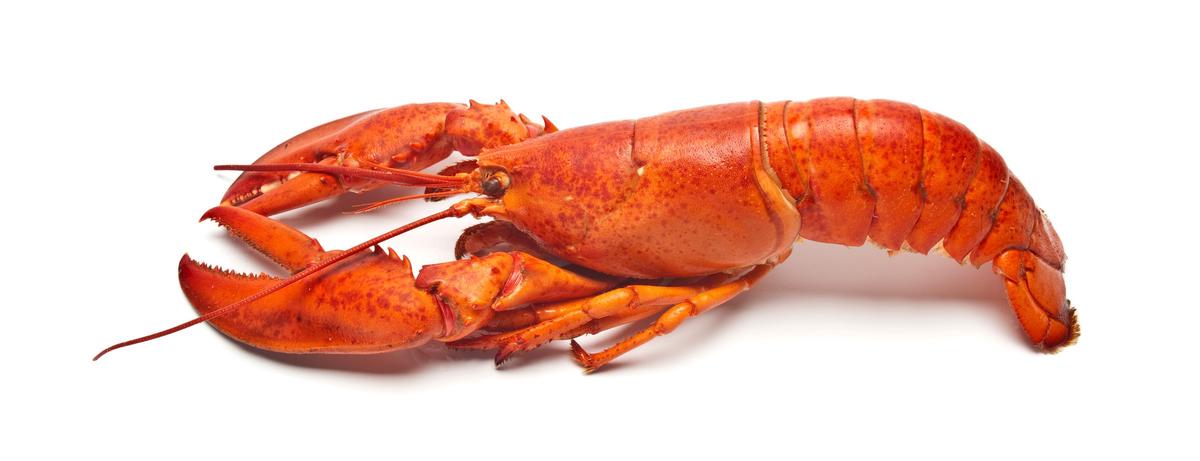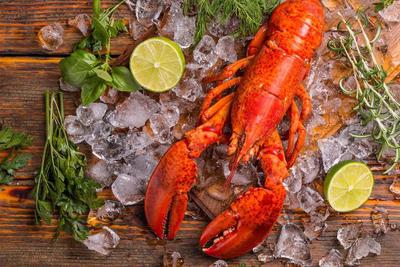Can Dogs Eat Lobster? - Too Much Fat?
These crustaceans are healthy right since they cost so much? Are dogs ok to eat them, we discuss the pros and cons of feeding lobster

Summary
Lobsters are one of those foods that people love to eat, but they don’t always think about serving it to their dogs. But lobsters aren’t just for humans anymore! They’re also great treats for dogs who enjoy seafood.
Can Dogs Eat Lobster 🤔?
The answer is yes! In general, most dogs do enjoy eating crustaceans including crabs, crawdads, crayfish, prawns, etc., because these animals contain high levels of protein and fat. However, there’s a big difference between what you can feed your dog versus the amount he should be consuming 🐕.
Dogs need at least 30% of their daily calories from proteins in order to maintain healthy muscle mass and function properly. This means if you give them more than this percentage, then they will start storing extra body fats which could lead to obesity or other health problems. So when feeding your dog lobster, make sure not to exceed 30%.
If you decide to serve your dog lobster as an occasional treat, here are some tips:
-
Make sure to buy fresh live lobsters if possible. Frozen ones may have been exposed to chemicals used during freezing process. These chemicals might affect the taste of the meat. Freshly cooked lobsters are safer to consume by any dog.
-
When cooking lobster tails, remove the tail meat first before cutting into smaller pieces. The rest of the shell contains calcium carbonate which makes it hard for dogs to digest. You can cut off the head too, but keep in mind that the heads usually contain lots of bones so it would be better to leave it intact.
-
Don’t overfeed your dog with lobster. A good rule of thumb is to only offer him 1/4 cup of raw lobster meat every 2-3 days.
Why Shouldn’t Dogs Eat Lobster?
Overall, it’s a food for your dog in moderation, however, there’s usually downsides to any food. An example of why you shouldn’t feed lobster to your dog is its high-fat content. As we mentioned before, lobster has a lot of fats which makes it a little unhealthy for our pets. In order to keep them fit and active, they need low-fat diets. So, feeding your pet with lobster won’t help him stay leaner and healthier.
Another thing is that lobster contains toxins called Dioxins. These chemicals are dangerous for both human beings and animals alike. If ingested, dioxin accumulates in fatty tissues such as liver, kidneys, heart, lungs, brain, spleen, pancreas. Some studies even suggest that dioxins cause cancer. Therefore, don’t just feed them a lobster diet (plus that would be very expensive 😛).

Allergies 🦐
Another problem associated with eating lobster is allergies. Many people and animals suffer from allergic reactions after consuming seafood products like lobster. These reactions include hives, itching, swelling, nausea, vomiting, diarrhea, and even death. Allergic reactions are caused by proteins found in foods. When consumed, these proteins trigger immune system responses that cause symptoms similar to those experienced during allergy attacks. Therefore, it is important that you keep away from lobster-based meals or snacks for your dog. Only give them a small part if it’s their first time trying and monitor the results.
-
High Value Of Sodium Shells: Although lobster has no harmful substances inside its body, its shells still contain toxins that can harm your dog’s digestive system. In case your dog eats lobster shells, he might experience vomiting, diarrhea, abdominal pain, or even worse.
-
Bellyache: Eating too much lobster could cause your dog to suffer from indigestion, gas, bloating, or even more serious conditions like ulcers or gastritis.
-
Shocking Hazards Shells: Although lobster has no harmful substances inside its body, its shells still pose danger to your dog. They’re hard enough to break teeth and cause damage to gums and mouth. In case your dog eats them, he’ll experience pain and discomfort.
Lobster contains calcium phosphate, which is used by our bodies to build strong bones. When we consume too much of it, it causes kidney stones.
Another problem associated with lobster is that it contains a lot of fats and cholesterol. These two substances can be harmful to dogs digestive systems. However, on the upside these foods contain a large amount of proteins, vitamins, minerals, and fiber.
All of these components contribute towards making up the nutritional value of the food. When fed to dogs in large quantities, these elements may cause problems like diarrhea or constipation. Such conditions could make your dog sick and in extreme cases, result in death.
How to cook lobster for your dog 🐕
Cooking lobster isn’t difficult, especially if you’ve done it before. Here are 3 easy ways to cook lobster for your dog:
-
Boil Lobster Shells - Put uncooked whole lobster shells in boiling water until soft. Then drain and rinse thoroughly under cold running water. Discard any remaining liquid after rinsing. Remove the meat from the shells using kitchen shears. Cut each piece into bite-size chunks and serve immediately.
-
Steam Lobster Meat - Place uncooked lobster meat in a steamer basket above simmering pot filled with hot water. Cover and steam for 15 minutes. Turn heat down to low and continue to steam for another 10 minutes. Drain excess moisture and discard.
-
Bake Lobster Meat - Preheat oven to 350 degrees Fahrenheit. Wrap uncooked lobster meat tightly in aluminium foil. Roast for 20 minutes. Unwrap and let cool completely, then slice and serve 👌.
Health benefits
If you want to give your pet a healthy dose of omega 3s, then feeding him/her seafood is one way to achieve this goal. Omega 3 fats help keep skin, coat and joints healthy by reducing inflammation and promoting cell growth. Lobser also contains high levels of vitamin D, B12, iron, zinc, phosphorus, magnesium, copper, manganese, selenium, iodine, potassium, sodium, and protein. This makes lobsters an excellent source of nutrients for both humans and pets alike.
Vitamin D helps maintain bone health while maintaining proper blood sugar level. It also promotes good digestion and absorption of other essential nutrients such as calcium, phosphorous, and magnesium. Vitamin D deficiency leads to osteoporosis, brittle bones, muscle weakness, and poor immune function.
The mineral content of lobster includes calcium, phosphorus, sulfur, chlorine, bromine, and fluorine. Calcium plays important role in building strong bones and teeth. Phosphorus aids in forming energy-rich compounds within cells. Sulfur contributes to the formation of connective tissue. Chlorine prevents bacteria from growing on surfaces. Bromine strengthens hair follicles and protects against sunburn.
Fluorine keeps teeth white and shiny and also has anti-inflammatory properties which can reduce joint pain caused by arthritis. The presence of trace amounts of mercury in some types of fish, however, should not be ignored. If you’re concerned about possible toxicity, consult your veterinarian first.
A single serving provides 7 grams of protein. That’s more than most meats provide, it is necessary for repairing damaged tissues and keeping muscles working properly 💪.
How much should I feed my puppy?
The recommended daily allowance of fish oil for puppies is 1-5 millilitres per kilogram of their weight. The RDA for adult dogs is 2-6 ml per kg of their weight. If you feed your puppy less than what his RDAs recommend, he/she will not get all the essential fatty acids needed for proper development. On the other hand, overfeeding on certain types of oils such as flaxseed oil can lead to health issues. So how do you know when to stop giving your pup lobster? Well, there’s no set rule but here are some guidelines:
- Don’t feed your puppy more than 5% of his total diet.
- Avoid feeding your puppy raw meats because they have bacteria that can affect digestion.
- Do not feed your puppy anything containing shellfish since they contain dangerous chemicals.

What are some other seafood treats canines enjoy eating?
There are many different types of fish and seafood that dogs like to eat. Below we list some popular choices along with information regarding safety and nutrition.
Fish & shrimp
These two foods are very similar in terms of nutritional value. Both are rich sources of omega fatty acids, vitamin D, iron, zinc, selenium, phosphorus, potassium, copper, manganese, iodine, magnesium, niacin, pantothenic acid, thiamine, riboflavin, B12, folic acid, choline, phosphorous, and vitamins C and E. They also provide small amounts of protein, carbohydrates, fiber, and essential amino acids such as lysine, methionine, cystine, tryptophan, histidine, arginine, leucine, valine, phenylalanine, tyrosine, proline, alanine, glycine, serine, glutamic acid, aspartic acid, and citrulline.
When choosing shrimp or crabmeat, look for those labeled 100 percent since they’re free of additives and preservatives. Avoid buying frozen items unless they were previously defrosted. Also avoid canned products since they often contain added salt. Instead, opt for freshly prepared dishes made with natural ingredients.
Canned Salmon
Salmon has become one of the top selling pet foods due to its popularity among both humans and pets. It provides plenty of Omega-3 fatty acids, Vitamin D, minerals, and trace elements. But just like other seafood, salmon must be kept away from strong flavors and odors. If possible, choose fresh wild caught salmon instead of farmed varieties. This will ensure a higher quality product.
Tuna
This type of food can be found in various forms including flakes, pieces, and even ground up. Tuna contains high levels of healthy fats, proteins, and antioxidants. However, tuna should not be fed more than once per week because too much can cause an upset stomach.
What Are Other Treats That Your Dog Would Enjoy Eating?
Aside from lobster, there are plenty of other delicious treats that your dog would like to try out. Below are some examples:
- Chicken Breast - It’s very nutritious and tasty. Just remember to use chicken breast without skin since it contains less cholesterol compared to dark meat. Also, make sure to wash the chicken thoroughly before preparing it for your dog.
- Salmon & Tuna - Both salmon and tuna are rich sources of omega 3 fatty acids. Omega 3 helps improve overall immune system and keeps joints flexible.
- Eggs - Egg yolks are packed full of nutrients and vitamins. Plus, eggs are relatively cheap.
- Cheese - There are different types of cheese available depending on your preference.
Risks of Feeding Seafood to Dogs
As mentioned above, not every kind of seafood is suitable for feeding to dogs. Here are some common dangers associated with certain kinds of fish and seafood:
Mercury poisoning
As we’ve mentioned above, fish can contain large amounts of mercury, especially larger ones like shark, swordfish, tilefish, marlin, grouper, cod, halibut, sardines, herring, and albacore tuna. Mercury accumulates over time so if you feed these fishes regularly, then chances are your dog could get sick. The best way to prevent this problem is by only purchasing whole fish rather than fillets. You can ask your local butcher shop to prepare them for you.
Dioxins
Fish containing dioxins include bluefin tuna, shark, swordfish, sea bass, flounder, sole, catfish, tilapia, snapper, mullet, and anchovies. These toxins accumulate in fat cells which means that when consumed, they stay longer in the body. So, if you want to keep your dog safe, don’t give him any of these fishes.
Pesticides
Some fish have been contaminated with pesticides. For example, farm-raised Atlantic salmon is usually treated with chlorinated hydrocarbons while Pacific salmon is treated with organochloride insecticides. Pregnant women who consume these fish during pregnancy might pass along harmful chemicals to their unborn babies.
Conclusion
Feeding your dog lobster is safe and nutritious. It helps improve overall health and well being. But remember, just like human beings, dogs need to avoid consuming excessive amounts of certain kinds of foods.